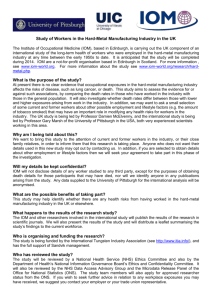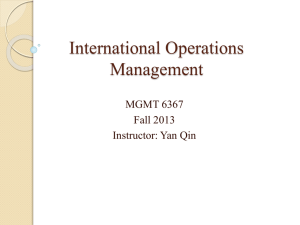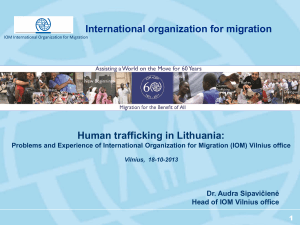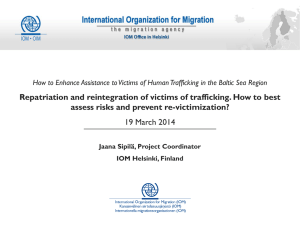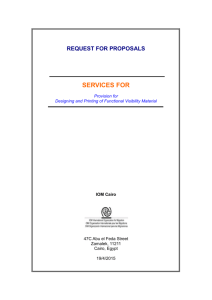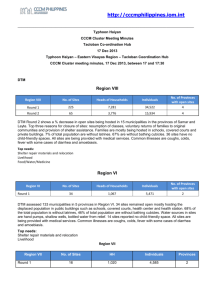Stakeholder Webinar Slides
advertisement
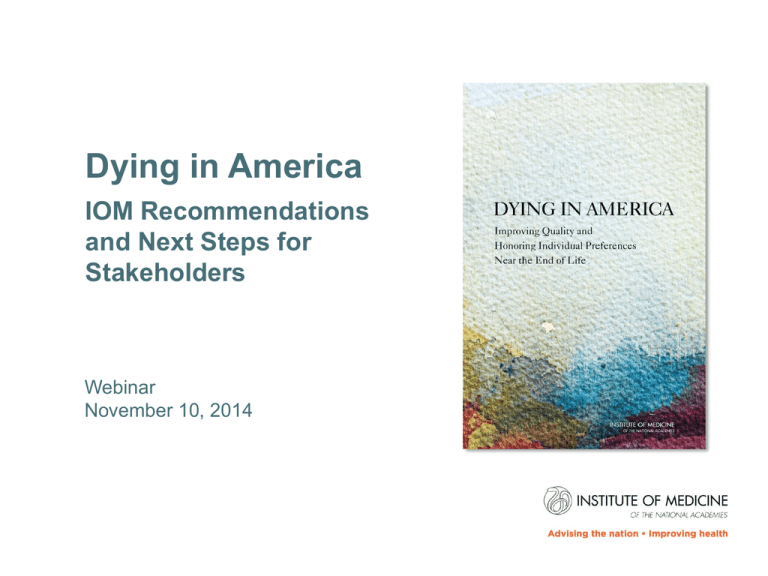
Dying in America IOM Recommendations and Next Steps for Stakeholders Webinar November 10, 2014 Agenda Welcome Laura DeStefano, Communications Officer, IOM Study Overview Adrienne Stith Butler, Study Director, IOM Care Delivery and Clinician–Patient Communication Philip Pizzo, Committee Co-Chair, Stanford University School of Medicine Professional Education Christian Sinclair, Committee Member, University of Kansas Medical Center Policies and Payment Systems and Public Education and Engagement David M. Walker, Committee Co-Chair, Former U.S. Comptroller General Q&A and Discussion Study Overview Adrienne Stith Butler, Study Director, IOM Statement of Task The IOM will conduct a consensus study that will produce a comprehensive report on the current state of medical care for persons of all ages with a serious illness or medical condition who may be approaching death and who require coordinated care, appropriate personal communication (or communication with parents or guardians for children), and individual and family support. The committee will assess the delivery of medical care, social, and other supports to both the person approaching death and the family; person-family-provider communication of values, preferences, and beliefs; advance care planning; health care costs, financing, and reimbursement; and education of health professionals, patients, families, employers, and the public at large. The study will also explore approaches to advance the field. See the report, p. S-4, for the complete statement of task. Committee Philip A. Pizzo (Co-Chair) Stanford University David M. Walker (Co-Chair) Former U.S. Comptroller General Patricia A. Bomba Excellus BlueCross BlueShield Eduardo Bruera MD Anderson Cancer Center Charles J. Fahey Fordham University Milbank Memorial Fund Pamela S. Hinds Children’s National Health System The George Washington University Karla F.C. Holloway Duke University Naomi Karp Consumer Financial Protection Bureau Jean S. Kutner University of Colorado Bernard Lo Greenwall Foundation Salimah H. Meghani UPenn School of Nursing Diane E. Meier Center to Advance Palliative Care Icahn School of Medicine William D. Novelli Georgetown University Stephen G. Pauker Tufts University Tufts Medical Center Judith R. Peres Clinical Social Worker/Policy Consultant Leonard D. Schaeffer University of Southern California W. June Simmons Partners in Care Foundation Christian T. Sinclair University of Kansas Medical Center Joan M. Teno Brown University Fernando Torres-Gil UCLA James A. Tulsky Duke University Care Delivery and Clinician– Patient Communication Philip Pizzo, Committee Co-Chair Stanford University Findings—Care Delivery • Multiple transitions between health care settings can fragment delivery of care and create burdens for patients and families • Demand for family caregiving and the responsibilities of family caregivers are increasing • Palliative care enhances quality of life, reflects patient choices, and supports families • Widespread timely referral to palliative care appears slow Recommendation 1 Government health insurers and care delivery programs, as well as private health insurers, should cover the provision of comprehensive care for individuals with advanced serious illness who are nearing the end of life. Complete recommendation available at www.iom.edu/endoflife Findings—Clinician-Patient Communication • Most people nearing the end of life are not physically, mentally, or cognitively able to make their own decisions about care. • Of people who indicate their EOL care preferences, most choose care focused on alleviating pain and suffering. • Frequent clinician-patient conversations about EOL care values, goals, and preferences are necessary to avoid unwanted treatment. • Incentives, quality standards, and system support are needed to promote improved communication skills and more frequent conversations. Recommendation 2 Professional societies and other organizations that establish quality standards should develop standards for clinician–patient communication and advance care planning that are measurable, actionable, and evidence based. These standards should change as needed to reflect the evolving population and health system needs and be consistent with emerging evidence, methods, and technologies. Payers and health care delivery organizations should adopt these standards and their supporting processes, and integrate them into assessments, care plans, and the reporting of health care quality. Complete recommendation available at www.iom.edu/endoflife Professional Education Christian Sinclair, Committee Member University of Kansas Medical Center Findings—Professional Education • The establishment of specialty practice in hospice and palliative medicine is a major improvement in the education of health professionals. • Three problems remain: • Insufficient attention to palliative care in medical and nursing school curricula • Educational siloes the impede development of interprofessional teams • Deficits in equipping providers with sufficient communication skills • Health professionals are not always adequately prepared to deliver “basic” or “primary” palliative care Recommendation 3 Educational institutions, credentialing bodies, accrediting boards, state regulatory agencies, and health care delivery organizations should establish the appropriate training, certification, and/or licensure requirements to strengthen the palliative care knowledge and skills of all clinicians who care for individuals with advanced serious illness who are nearing the end of life. Complete recommendation available at www.iom.edu/endoflife Policies and Payment Systems and Public Education and Engagement Dave Walker, Committee Co-Chair Former U.S. Comptroller General Findings—Policies and Payment Systems • Incentives under fee-for-service Medicare result in more use of services, more transitions among care settings, and late enrollment in hospice. • Programs that integrate health care and long-term social services may reduce hospitalizations and health care costs while improving patients’ quality of life. • Changes are needed throughout the health care system to incentivize provision of comprehensive palliative care. • Quality standards and measures are needed to ensure that changes in payment systems, particularly those under ACA, do not adversely affect EOL care quality. Recommendation 4 Federal, state, and private insurance and health care delivery pro-grams should integrate the financing of medical and social services to support the provision of quality care consistent with the values, goals, and informed preferences of people with advanced serious illness nearing the end of life. To the extent that additional legislation is necessary to implement this recommendation, the administration should seek and Congress should enact such legislation. In addition, the federal government should require public reporting on quality measures, outcomes, and costs regarding care near the end of life (e.g., in the last year of life) for programs it funds or administers (e.g., Medicare, Medicaid, the Department of Veterans Affairs). The federal government should encourage all other payment and health care delivery systems to do the same. Complete recommendation available at www.iom.edu/endoflife Findings—Public Education and Engagement • Need for public education and engagement is manifest at the societal, community/family, and individual levels. • Most Americans lack knowledge about EOL care choices, and the health community and other leaders have not fully utilized strategies to make that knowledge available, meaningful, and relevant across diverse groups. • Efforts are needed to normalize conversations about death and dying. • Several social trends suggest that the time is right for a national dialogue on this issue. Recommendation 5 Civic leaders, public health and other governmental agencies, communitybased organizations, faith-based organizations, consumer groups, health care delivery organizations, payers, employers, and professional societies should engage their constituents and provide fact-based information about care of people with advanced serious illness to encourage advance care planning and informed choice based on the needs and values of individuals. Complete recommendation available at www.iom.edu/endoflife Q&A and Discussion ? The IOM report suggests that the quality of conversations about EOL issues is important. How do the committee members define quality? What measures will help us determine quality? —Nick Jehlen, The Action Mill ? How do you think the shift in Washington, DC, post-midterms will affect the uptake of the committee’s recommendations? ? As a risk manager in a critical access hospital (read: limited resources), what is the one best thing I can do to get providers and staff on board with having EOL discussions? We own our physician practices, and would like to see physicians having this discussion during preventive and chronic care. ? Given all the current demands on primary care providers, can we expect them to provide a substantial amount of the palliative care needs of their patients as suggested in the IOM report? If so, what models exist for this and are there any outcome data? —J. Trig Brown, Duke University ? In an ideal world, how would you like to see consumers becoming involved in advocating for improving care for those with advanced illness? —Ellen Rand, Writer and Hospice Volunteer Thank you! Complete report and other resources available at www.iom.edu/endoflife Please let us know what you thought of this webinar: www.iom.edu/EOLwebinarpostsurvey #IOMEndofLife More information: Laura DeStefano (ldestefano@nas.edu)
